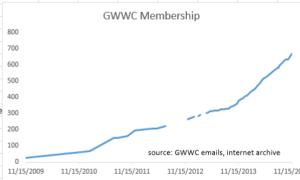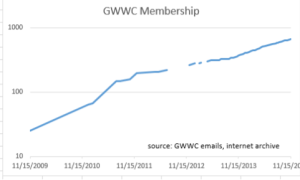Giving What We Can recently celebrated its 5th birthday. It's not much of a party if no-one external congratulates you, so here we go: Happy Birthday, GWWC!
It's pretty impressive how much GWWC has grown since those early days. Here's a chart of total membership, which I've put together from GWWC emails and liberal use of the internet archive. I'm sure they have better data (without gaps!) internally, but I've never seen this chart before. Notably, growth seems to have picked up since the fall of 2013. Did GWWC change their strategy at that point? (or their membership-counting-methodology?)
Putting the same chart on a log scale, we can see that GWWC have actually done a reasonably good job of sustaining exponential growth.
Fitting a line of best fit to the chart, I estimate GWWC's membership is growing 73.1% a year. Assuming 2% population growth, it will take just 30.25 years before all the world's population are GWWC members. Taking over the world by the time I'm 58 sounds like pretty good going!
Happy Birthday, Giving What We Can!
edit: formatting of links



Aww, thanks Dale! If you want to see the full graph, you can check out our dashboard: https://www.givingwhatwecan.org/dashboard . The interesting change of rate at the beginning of last September doesn't actually match a sudden change of strategy. We think that it's a combination of factors: we gradually increased focus on following up with people who seemed interested in GWWC / got part way through joining, we brought in different ways to start out on a pathway to membership rather than it being all or nothing (specifically by increasing focus on Try Giving), we got a full-time Director of Community to focus on membership (Ben Clifford started at the beginning of September), and interest in joining increased following Peter Singer's TED talk at the end of May that year.
Another potential explanation (entirely compatible with the above): Giving What We Can gradually started taking paid staff from the latter half of 2012; this was a big injection in terms of person-hours and money going into GWWC. Between start-up costs and the delay in terms of new initiatives being implemented and people actually joining as a result of those initiatives, the effects of this injection were only felt one year later.
A neutral look at the graph doesn't suggest that - it shows membership growth staying flat for a long time before and after Giving What We Can started taking money, which is at least equally compatible with the hypothesis that that money didn't increase membership. You couldn't say that any increase in membership at any point after this showed otherwise.
What were the new initiatives undertaken halfway through 2012 which plausibly led to more members over a year later?
A couple of reasons for thinking that having full-time staff had this delayed effect are that we were trying out a variety of strategies, and that our ‘ask’ is quite large, and hence it can take a while from people first hearing about us to actually wanting to join. For the first few months of having staff, we were working on a redo of the website, particularly branding and introducing a blog. When we launched that, web-traffic doubled. We then focused on a media push, which led to us being on NPR, BBC and mass media in January. That led to quite a bump in web-traffic, but not an increase in membership. At that point we pivoted to being more focused on the pathway to membership – to try to increase the number of people getting from initially hearing about us and reading the website to actually joining. This involved a number of things – for example improving the pathway through the website and trying out different ways of reaching out to people. It seems likely that the increasing rate in 2013 was (at least to some degree) a confluence of our focus on increased first contacts in late 2012, and on conversions in early 2013.
As someone who was heavily involved in GWWC over that period, I think the explanation that we got much better at converting staff hours into new members is a large part of the explanation for membership growth suddenly rising much faster from mid-2013.
The package of things we were working on before that wasn't so effective at getting people all the way to joining.
The other contributing factor is probably a growing general interest in effective altruism (for which GWWC can claim some but certainly not all of the credit).
Thanks that's interesting. What's the current package of ways of getting people to join and how long does it normally take?
Hey jayd, basically we try to have people working on broad outreach (events, social media, media coverage, chapters) and then someone else working on taking the emails and names we get, and contacting people individually to ask them to become members. This often involves lengthy email exchanges to discuss their reservations. We have found persistence works well, and doesn't bother almost anyone, as people are more often procrastinating than refusing.
Basically, before mid-2013 we were not systematically doing this personal follow-up, so it is no surprise we weren't getting many people to sign on the dotted line.
Oh nice, congratulations on making the data publicly available! I'm irrationally pleased that my chart is the same shape, though this shouldn't be a surprise, as the data did come from GWWC.
btw you need to remove the period from the link like this for it to work. Also I am concerned that the number of people currently engaged in trying giving drops so much in 2016, though impressed with your prescience!
Haha, well it definitely shows you did a good job patching it together. Thanks, fixed. Most people use Try Giving for a short period - they test out giving 10% for 6 months before deciding whether to join, or they commit to giving 5% for a year with the aim of working up the following year. We don't really encourage super long-term Try Giving pledges. So there aren't many people currently signed up whose Try Giving pledge lasts into 2016.
Cool, it would be great if they could sustain exponential growth! I imagine this may happen from people getting into these ideas and then telling their friends, who tell their friends, who tell their friends, and so on. That seems a good hypothesis to explain the exponential trend.
Does GWWC know how many of these members would have been donating significant sums without GWWC? Presumably they share this information with donors? I realise this is hard to work out, as people who are interested in these ideas would likely have come across GiveWell and EA at some point anyway.
On your second point of how much people would have donated without signing the pledge, people who sign the pledge are asked "What percentage of your income would you have donated over your lifetime if you had not come across Giving What We Can?" I'm pretty sure the answer to this question is used in figuring out the money moved figure.
Indeed we do Markus. Vincent - that has happened much less than we expected - it's quite a difficult thing to talk to friends about. The pattern seems more readily explicable as the step change I described above.
Ah, great that they make this public - where would I find it, and the working behind it to answer my question?
We do a review of the organisation each year or so. I'm currently working on the review for 2013 (we have to do it the following year, so that we have all the data on donations etc). The one for 2011-2012 is here A brief summary of that / general review is here
Thank you, that review of 2011 and 2012 looks like a very interesting, detailed read. It does seem to cast doubt on the exponential growth model that I was excited about which is a shame, but I still think that could happen. I couldn't see information about how many GWWC members would be donating significant sums without GWWC on my first read, am I missing that? Will it be in the next impact review?